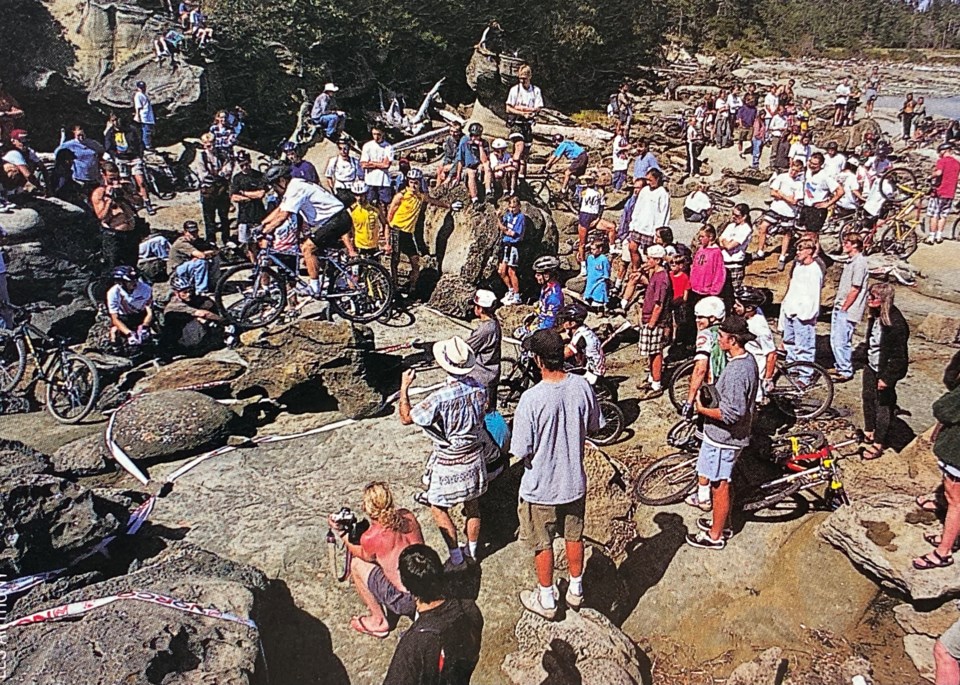Call me naive, but until I saw a demonstration in Pemberton in 1995, I had no idea an entire subculture of mountain biking—trials—existed in which people balanced in upright wheelies atop sawed-off logs, bunny-hopped sideways over the necks of petrified human volunteers, and pogoed cycles up and down mounds of tottering rubble, eventually jumping to the ground off the roof of a battered pickup that more readily conjured images of a monster truck rally than two-wheeled athletics.
Nevertheless, this display of balance, strength and impressive marginalia drew me that summer to a now-defunct bike-o-centric celebration known as Hornby Island Bike Fest, an event that more than any other in those early days of the sport seemed dedicated to the entire depth and breadth of the mountain-biking experience.
Upon arrival it was clear Hornby’s deal was mountain biking. Even then, a trail network held the island together like a well-woven salmon net: you could cross from one side to another from anywhere by linking singletrack with bits of old logging road. The nexus for all of this was the 150-acre family farm of bike-shop owner and Bike Fest impresario Tig Cross.
At the farm, I’d set up camp in a mowed field beside two teens from Victoria named John and Morely who’d bussed part way up Vancouver Island, then pedalled the rest of the way on their one-speed trials BMXs. We were the only people on the vast acreage when we retired early in the evening, but the solitude didn’t last. By midnight, a microcosm of every facet of mountain biking had trickled in: not only trials riders but dual slalom, cross-country, and downhill peeps. Some serious, some not so much. There were men, women, children, pets, dirtbags, debutantes, jerks, jocks and Vancouver A-type weekend warriors, along with partyers and teetotallers, Jesus freaks and NORML crusaders, hippies and rednecks.
By the time the B.C. Trials Championships started next morning on a boulder-littered rock shelf near the island’s main beach, I was deeply engrossed in the alien proceedings. The short trials courses—collections of incredibly technical manoeuvres compressed into a few short yards—traversed the lunarscape leftovers of sandstone, glaciation and relentless tidal erosion. As the crowd surreally perched atop mushroom-like rock formations, the contest began.
It was wild stuff, with enough serious biffs to explain the profusion of shinpads and other protection I’d never before seen. While the cornucopia of bike categories and their componentry was also mesmerizing, the show the riders put on blew neophyte observers like myself away.
Later, back at the farm for the second part of the championships, Morley wondered why bike magazines didn’t cover trials. I thought of the 20 or so competitors versus the hundreds of cross-country and downhill racers and the answer seemed obvious. But Morley had given me pause to reconsider. “It’s a real crowd pleaser,” he’d noted, pointing to the hordes crowding into Tig’s barn to watch riders tackle a series of stumps, beams and ladders. He had a point. Many famous early mountain-bike racers had ridden trials on small bikes before cross-country and downhill became popular. “It’s what made them great technical riders,” Morley added.
Friday night was typical of a few hundred people camping together: beer flowed like tapwater, and music drifted into the sky from every quarter. RCMP on mountain bikes cruised the encampment, their presence enough to keep a lid on things. At one point, loud teens on the loose threatened any hope of sleep, but they passed out almost in unison, leaving only crickets chirping under the stars.
With cycling already a big part of life on an island swathed in gravel roads and forest paths, mountain bikes made instant sense, and Tig had acquired his first in 1981, age 11. The idea for an event came years later during a debauched evening with friends who’d agreed to do something cool around mountain biking. The first Bike Fest in 1989 drew 13 riders, the next 83, then 190; when a party/dance was added to the fourth, the number of registrants leapt to more than 300—impressive for any offshore event. The seventh edition I attended saw 400 competitors, with 17 classes in cross-country alone.
Bike Fest’s success galvanized the island’s youth into a mountain-bike mad lot, so it wasn’t surprising to see wide-eyed spectators gather at the cross-country start. The cheerleaders included the vociferous females familiar to any little-league bleacher scene known as “hockey moms.” Waves moving through the start were like a reverse time-lapse of mountain-bikers aging; in the final class, kids so small their CamelBaks resembled expedition packs stood on their pedals at the gun as the hockey moms roared.
Once the start cleared, the crowd filtered uphill into the forest to follow the incoming racers. In sun-dappled woods, riders dropped into the barrel of a trail called “No Horses”—an incredible series of banked turns that represented an unheralded marvel of dirtbag engineering in those pre-bike-park days. The ground shook as riders thundered by, zipping up and down the dirt walls. As the spectacle continued, some observers began trickling over to the dual-slalom qualifiers on a nearby grassy slope, where an entirely different hell-bent breed was at play.
The carnage of a beer-fuelled outdoor concert that night ensured the next day’s downhill started late. Memorable morning visuals included a lycra-and-plastic-clad Darth Vader strolling a sea of collapsed tents and passed-out kids like some interplanetary conqueror. With so many factions that were all essentially connected yet fundamentally different, Hornby had seemed a planet unto itself, orbiting the outer galaxy of the mountain-bike universe.
I’d gone for the novelty of watching trials but came away convinced that this greater universe could only keep expanding.
Leslie Anthony is a Whistler-based author, editor, biologist and bon vivant who has never met a mountain he didn’t like.




